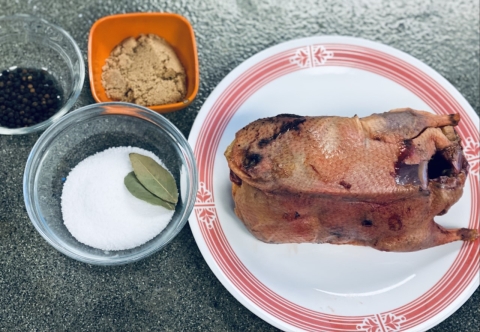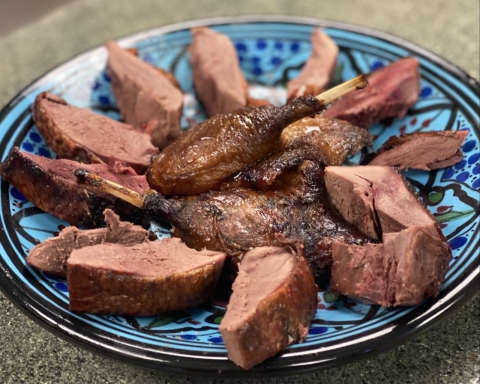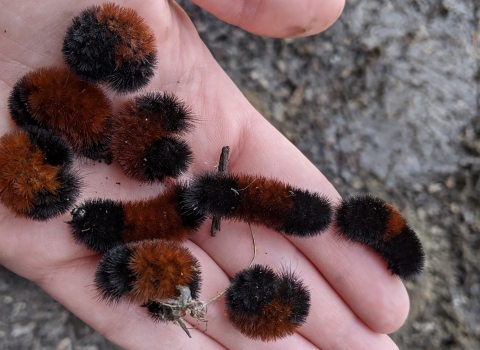There are always people who say they don’t like eating duck. Then they eat smoked duck. Then they shut up.
July’s mid-summer heat can make waterfowl season seem a long way off. But if you had success during hunting season last year, there’s a chance that you still have some ducks in your freezer that you want to polish off. Nice warm weather always inspires me to get the smoker out. Here’s a recipe to convert the finicky eaters in your life so you don’t have to—wait for it—wing it.
Mise En Place
First, foremost, always: “mise en place,” which is a French expression that means “put in place.” You need to have all your gear, ingredients, and anything else you may need together and organized before you start cooking. Live by this in the kitchen.
Equipment
Smoker: Use whatever smoker you want. I’ve done this recipe with side fire boxes (common in the barbecue world), stand up smokers (the ones that look like R2D2 but without the attitude), and pellet smokers (totally cheating but make great food). Propane and electric smokers should work as well. Use what you have and what you’re comfortable with. I’ve provided directions for using lump charcoal and hardwood.
Wood/Charcoal: Use lump hardwood charcoal as a base, and the hardwood of your choice for smoke (see more on choosing wood below).
Boning knife: Sharp as always. Just don’t have dull knives. It’s not cool, and no one will like you if your knives are dull. Though dull knives are a good way to get to know your local urgent care or emergency room doc for stitches.
Cutting board: Self-explanatory.
Bowl: Big enough for your brine.
Ingredients
The duck: Use a whole duck that has been properly plucked (smoked feathers taste horrible). I used a mallard killed in November 2021 on Umatilla National Wildlife Refuge for this recipe, though you could choose other species. Northern pintail should be excellent, as would green-winged teal (just beware of how small they are), canvasback, and probably wigeon. Here’s a wild card that might start an argument: Ring-necked ducks are delicious little divers that don’t get a lot of attention on the plate, but I think that’s because nobody talks about them.The brine: Brining is key here. It adds moisture, improves flavor, and people will think you’re hard-core. I don’t usually measure the brine ingredients, but here’s a start:
Approximately ¼ cup kosher salt. Sea salt works too. Don’t use iodized salt for this because it will impart a metallic flavor to the brine.
Approximately ½ cup brown sugar.
2-3 bay leaves.
A handful of black peppercorns.
6-8 cups of water, or enough to cover your duck(s).
Optional: Some dried whole red peppers won’t hurt anything and will add to the flavor.
The smoke: I consider smoke an ingredient in this process because the smoke you choose affects the flavor. You can use your favorite hardwood smoke. I would stay away from mesquite here, and while I’m not going to come to your house and yell at you if you use it, consider yourself warned that mesquite is a strong flavor and can overpower some meats. I lived in Texas for nearly eight years and most barbecue places there blend their mesquite smoke with other hardwoods to avoid this. Texans know what they’re doing when it comes to barbecue. Do yourself a favor and try one of the following: alder, apple, cherry (not my favorite but works), dry grape vine (this is our secret), hickory, maple, pear, persimmon, or some combination.
I use lump hardwood charcoal (available pretty much anywhere) as a base for my smoke. Once the charcoal is hot, I add my wood of choice to the coals. I generally smoke over an indirect heat at about around 225-250 degrees until the duck is about medium done. The smoke time can vary and depends on your smoke and size of the duck. It will probably take a couple of hours at least but pay attention. You’ve come too far to ruin it now.
Method
- Make the brine by combining the kosher salt and brown sugar with enough water to cover your bird. Whisk this mixture together until the salt and sugar are dissolved, then add a couple bay leaves, peppercorns, and the dried peppers if you’re feeling bold. Taste the brine. It should be salty and sugary.
- Cover your duck with the brine and place in the refrigerator for 4 to 6 hours or overnight. The exact time doesn’t matter too much, so take a deep breath. Hot tip: put a small plate on the duck to make sure it’s completely immersed in the brine.
- After brining, dump the brine and pat your duck down with a paper towel until dry. Put back in fridge and let it sit for a couple of hours until the skin feels tacky. This tackiness is called a pellicle and will help your smoke adhere to your duck later. It’s science.
- Set fire to your lump charcoal, and when the coals are hot add them to the smoker. After that, add your hardwood. You can soak the wood if you’d like but it’s not 100 percent necessary. You’re not looking for a thick smoke here. A small amount of blueish smoke is ideal.
- Smoke the duck. This takes some practice but over time you’ll get good at determining when it’s done. The U.S. Department of Agriculture recommends cooking duck to 165 degrees, but you can experiment to see what you like.
- Take duck off the smoke and let it rest for 20 minutes or so. Never cut directly into meat that you’ve pulled off a smoker/grill/oven until it has had a chance to rest. Otherwise, you’re ruining it for you and everyone else involved. You’ll be friendless and sad.
- Carve the duck and serve. Compatible sides include rice, green salad, and green beans (don’t smoke these—see friendless and sad comment above). Options for sides are wide open. You can also serve the as a stand-alone appetizer with the sauce of your choice.
Some Parting Thoughts
- Do not throw your duck carcass in the garbage. Freeze it. The carcass can be used to make the best stock imaginable, and if you don’t make your own stock, you don’t like cooking and eating.
- You can make this recipe with a domestic duck from the store, but it won’t be as much fun as cooking it with your own wild harvested birds. It’s not as hard as some people think, though it does require you to go outside and quit looking at your social media profiles for a bit.
Prepping for Next Year
After you’ve eaten and napped, go buy your 2022-2023 Duck Stamp and start thinking about upcoming waterfowl seasons.
Inventory and prep your waterfowl hunting gear. Fix decoy weights and lines, order new calls, inventory your ammunition and get what you need now so you’re not stuck in line the day before the duck opener. Clean your shotgun that has been waiting for oil since January. You know who you are.
Attention to mise en place for gear is just as important as living by that rule in the kitchen. You’ll have more fun and will be more effective throughout the season.
Never been duck hunting? Go with a friend who hunts or attend one of the basic training courses offered by state agencies and conservation organizations. Maybe you have a friend who hunts? It’s never too late to learn.
Smoked duck is a dish that can be enjoyed throughout the year—you don’t need to eat it just in the summer. My family likes to have a couple smoked for Christmas Eve dinner every year, or whenever we have the desire to watch some smoke ease out of the smoker and across the neighborhood. Watch out though—your neighbors might just crash your party.







